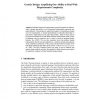Free Online Productivity Tools
i2Speak
i2Symbol
i2OCR
iTex2Img
iWeb2Print
iWeb2Shot
i2Type
iPdf2Split
iPdf2Merge
i2Bopomofo
i2Arabic
i2Style
i2Image
i2PDF
iLatex2Rtf
Sci2ools
DAGSTUHL
2003
2003
Genetic Design: Amplifying Our Ability to Deal With Requirements Complexity
Individual functional requirements represent fragments of behavior, while a design that satisfies a set of functional requirements represents integrated behavior. This perspective admits the prospect of constructing a design out of its requirements. A formal representation for individual functional requirements, called behavior trees makes this possible. Behavior trees, derived by rigorous translation from individual functional requirements stated in natural language, may be composed, one at a time, to create an integrated design behavior tree (DBT). We can then transition from this problem domain representation directly and systematically to a solution domain representation of the component architecture of the system and the behavior designs of the individual components that make up the system – both are emergent properties of a DBT. The Early Warning System case study is used to illustrate this genetic design method, and show its potential for defect detection and control of comple...
Behavior Tree | DAGSTUHL 2003 | DAGSTUHL 2007 | Individual Functional Requirements | Requirements Represent Fragments |
| Added | 31 Oct 2010 |
| Updated | 31 Oct 2010 |
| Type | Conference |
| Year | 2003 |
| Where | DAGSTUHL |
| Authors | R. Geoff Dromey |
Comments (0)

